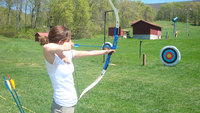Posted by Heidi C on 10th May 2016
Where to practice archery?
You decided to take up archery as a sport but since you are new to it, you overthink on the what, where, and how. Distract yourself. If you are feeling overwhelmed and anxious, try to distract yourself from your problem. Instead, try to shift your attention to something interesting that you can actually enjoy. Remember: Every archer must start somewhere. Read this article to alleviate your worries give you an idea where to practice archery.
If you want to try archery, look for programs through schools, clubs, city recreation programs or your local archery shop.
Where to practice archery

Should I Join an Archery Club?
By joining a club, you gain access to a certified instructor or coach, who can work with you in a group setting. Finding a good coach has been cited by many of the world’s top archers as a major determining factor in success. Adult and youth archers benefit from the instruction offered as part of club membership.
Another major advantage to joining a club is consistency: most clubs have a schedule of classes and/or lessons that take place one or more times per week. Class “sessions” often run seasonally, meaning 2-4 times per year, and are often 10-16 weeks long. Classes can be geared toward beginning, intermediate or advanced level archers – or all three. A bonus: archers of all ages tend to form lifelong friendships as part of their archery experience.
Club members are almost always encouraged to do what works for them – pursuing archery recreationally or competitively – but competition opportunities are readily available via the club’s instructor or coach, for those who want to try tournaments.
Every sport has rules and archery is no exception. The good news is that archery’s rules are clearly defined and very simple to understand. Below, you’ll find the basic guidelines of most archery ranges. Still, archers are strongly encouraged to work with the certified archery instructor at their local range or pro shop to understand each location’s unique rules.
On the archery range, safety is the first priority. Though archery is one of the safest sports, rules are designed to keep everyone safe and to facilitate fair play in competition.
3 Key Terms You Should Know
The waiting line is exactly what it sounds like: a line that keeps archers in a designated waiting area until it’s their turn to begin shooting. In reality, this line can be a few yards or several feet behind the shooting area, but it is almost always clearly designated.
One way you can instantly boost your mood or views on a troubling/stressful situation you may find yourself dealing with is to take a brisk walk. It can be around your block or further if you so choose. Exercise is an important part of keeping your mind and body active which will in turn, assist with your other personal developmental goals and aspirations.
The shooting line mark where archers stand when actually shooting their bows. In World Archery and USA Archery sanctioned target archery tournaments, archers stand with one foot on either side of this line. In National Field Archery Association tournaments, archers stand directly behind the line.
The target line is often present at archery ranges, and is a line about 3-4 feet in front of the targets, which acts as a “speed bump” for younger archers approaching the targets to pull their arrows. Some instructors will ask archers to wait at the target line and take turns advancing to retrieve their arrows.
End the day in a constructive way: think about what went wrong and visualize how you would have liked it to go. This way, you release the negative thinking around it, and get a better night's sleep knowing you have let it go. Eventually, your days might start going better too.

